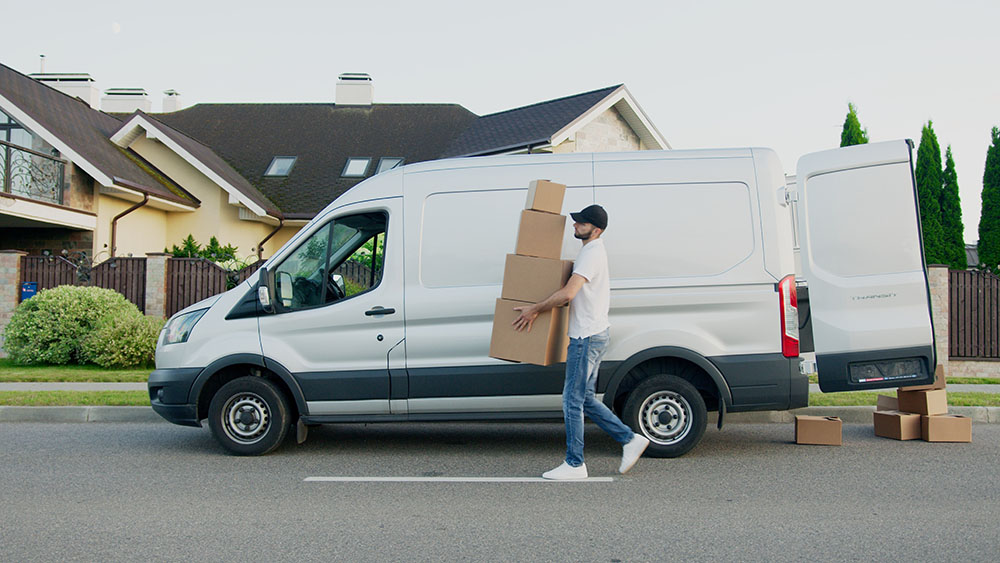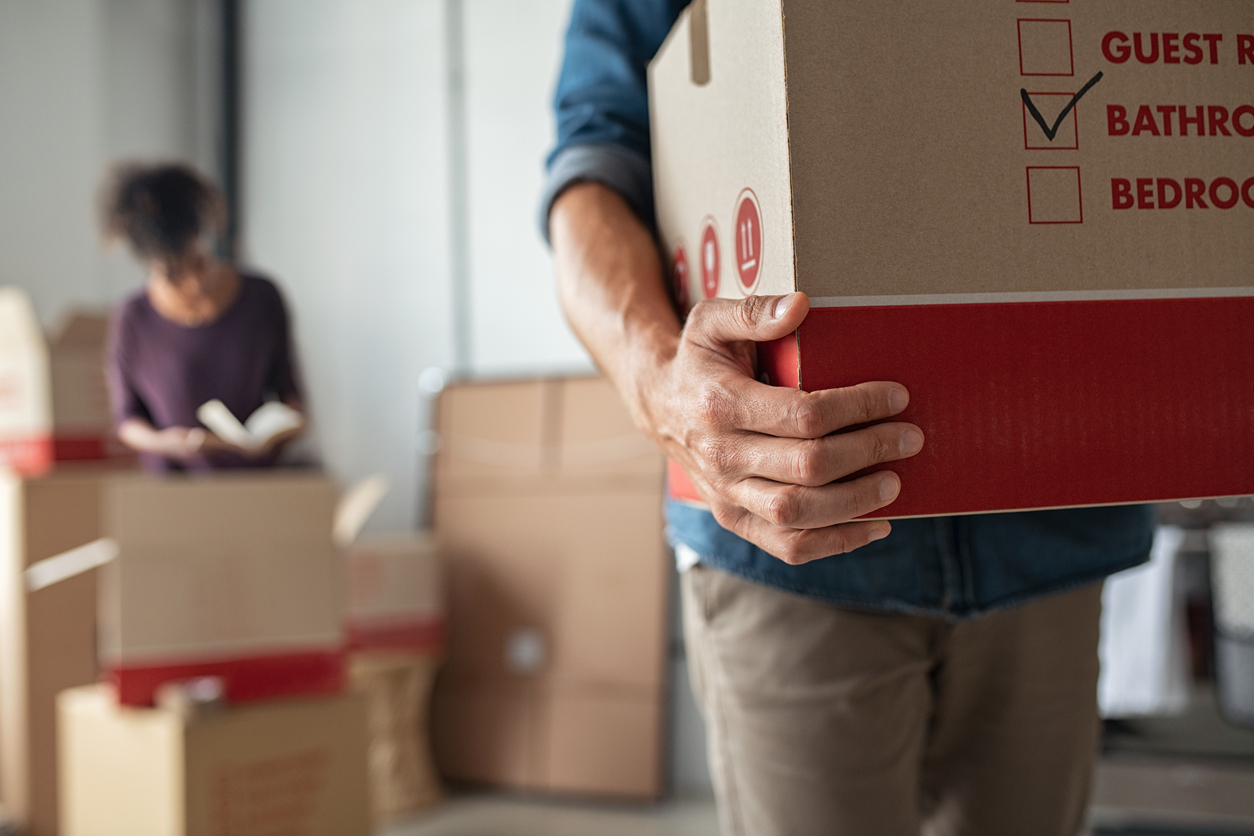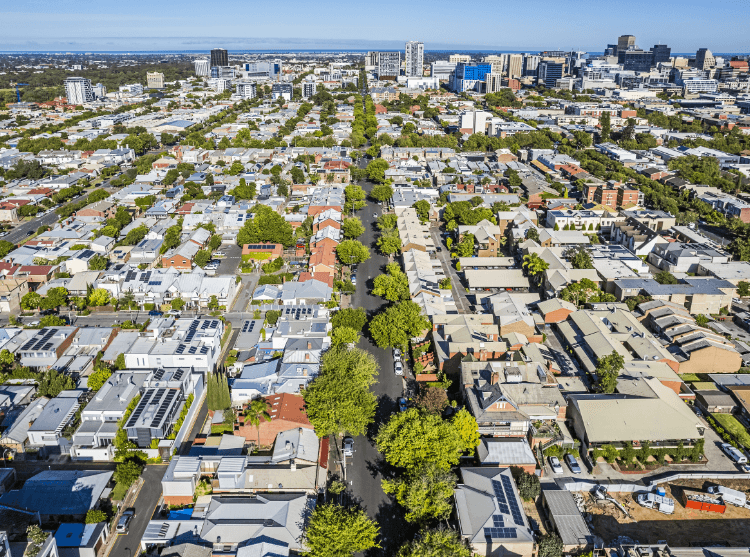In an era where environmental consciousness is paramount, individuals and businesses are increasingly seeking eco-friendly alternatives in every aspect of their lives, including the often-overlooked process of moving. This blog aims to shed light on sustainable moving practices. From choosing recyclable and biodegradable packing materials to responsibly disposing of unwanted items, we explore every facet of eco-friendly moving to make your transition not only convenient but also environmentally conscious.

Choosing Sustainable Packing Materials:
Exploring Options for Recyclable and Biodegradable Packing Solutions
The traditional use of plastic bubble wrap and Styrofoam, known contributors to environmental pollution, is replaced by eco-friendly options that prioritise the health of our planet. By exploring alternative packing materials, we pave the way for a more sustainable and environmentally conscious moving experience:



1. Recyclable Cardboard Boxes:
Instead of using one-time plastic boxes, opt for recyclable cardboard boxes. These boxes are not only sturdy and reliable for packing your belongings but can also be recycled after use. Recycling cardboard reduces the need for new materials and helps cut down on the environmental impact associated with single-use plastics.
2. Biodegradable Packing Peanuts:
Traditional packing peanuts made of Styrofoam can take centuries to break down and harm the environment. Biodegradable packing peanuts, on the other hand, are made from natural materials that break down over time without causing harm. Choosing biodegradable packing peanuts ensures that even if they end up in the environment, they won’t stick around for long, minimising ecological impact.


3. Eco-Friendly Padding Materials:
These materials are designed to protect your belongings during the move while being environmentally friendly. Examples include padding made from recycled or sustainable materials. By choosing eco-friendly padding materials, you ensure that your items are well-protected without contributing to environmental pollution. These materials often have a lower carbon footprint and are produced using more sustainable practices.
These alternatives offer practical and eco-conscious solutions for packing during a move. They not only provide effective protection for your belongings but also contribute to reducing waste and environmental harm. Making the switch to recyclable and biodegradable materials aligns with a sustainable mindset, ensuring that your move is not just convenient but also a positive step towards a greener future.
Minimising Waste During Your Move:
Tips for Reducing, Reusing, and Recycling Effectively
In the pursuit of a sustainable move, minimising waste emerges as a crucial focus. To achieve this, proactive steps can be taken, starting with a mindful decluttering of belongings before the move:






1. Mindful Decluttering:
Before packing up for your move, take the time to declutter your belongings. Assess each item and determine whether it is essential or holds sentimental value. Unwanted or unused items can be set aside for donation or other responsible disposal methods.
2. Donating to Local Charities:
Instead of discarding items that are still in good condition, consider donating them to local charities. This not only helps those in need but also extends the lifecycle of your belongings, diverting them from the landfill. Many charitable organisations accept a variety of items, from clothing and furniture to household goods.
3. Creative Reuse of Materials:
Take a creative approach to waste reduction by finding new uses for materials. Sturdy cardboard boxes, for example, can be repurposed for storage or organisation in your new home. This approach minimises the need for additional storage solutions and contributes to a more sustainable lifestyle by giving items a second life.




4. Minimalist Approach:
Embrace a minimalist mindset during your move by focusing on the essentials. The less you bring with you, the fewer items that need to be packed, transported, and unpacked. This not only simplifies the moving process but also significantly reduces the amount of waste generated, as you are consciously choosing to prioritise quality over quantity.
5. Reuse Packing Materials:
When packing your belongings, consider reusing materials from previous moves or collecting gently used packing materials from friends or family. This not only reduces the demand for new materials but also lessens the environmental impact associated with the production and disposal of packing supplies.
By incorporating these tips into your moving strategy, you actively contribute to waste reduction, promote a circular economy, and make choices that align with environmentally conscious practices. Each step taken toward minimising waste during your move represents a positive contribution to a more sustainable and eco-friendly lifestyle.
Eco-Friendly Disposal of Unwanted Items:
How to Responsibly Discard Items You No Longer Need
Ensuring the eco-friendly disposal of unwanted items is not just a responsible choice; it is a pivotal aspect of maintaining a truly sustainable moving process. When it comes to saying goodbye to items that no longer have a place in your life, a conscious approach can make a significant difference.


1. Electronic Waste Recycling:
Electronic devices, from old smartphones to outdated laptops, should not be thrown in regular trash due to the environmental hazards associated with electronic waste. Instead, explore electronic waste recycling programs available in your community. These programs often provide dedicated drop-off locations or collection events where electronic devices are safely disassembled and valuable materials are recovered for reuse, minimising the environmental impact of e-waste.
2. Donation to Local Charities or Thrift Stores:
For furniture and other household items that are still in good condition but no longer needed, consider donating them to local charities or thrift stores. This approach not only gives these items a second life by placing them in new homes but also reduces the overall waste generated during the move. Donation centres typically accept a wide range of items, including furniture, appliances, and clothing.




3. Recycling Centers for Various Materials:
When recycling is the preferred option, identify local recycling centres that accept the specific materials you need to dispose of responsibly. Recycling facilities are equipped to process materials such as paper, plastics, metals, and glass, redirecting them into the manufacturing of new products. This process helps reduce the demand for raw materials and minimises the environmental impact associated with the production of new goods.
4. Research and Segregation:
Before disposing of unwanted items, take the time to research and understand the disposal options available for each type of material. Proper segregation of materials ensures that they are directed to the appropriate disposal or recycling facilities. This careful consideration contributes to the effectiveness of eco-friendly disposal methods and supports the broader goal of sustainable waste management.
By following these steps, individuals not only responsibly part ways with unwanted items during a move but also actively contribute to the reduction of waste in landfills, promote resource conservation through recycling, and support a more sustainable approach to managing the environmental impact of relocation. Each decision made during the disposal process becomes an opportunity to make a positive difference for both local communities and the planet as a whole.


Green Packing Tips: Efficient and Sustainable Packing Techniques
Beyond choosing eco-friendly materials, efficient packing techniques can also contribute to a sustainable move. Explore tips on maximising space, reducing the need for excess packing materials, and ensuring a smooth and organised packing process that minimises waste.


1. Reusable Soft Packaging: Cloth and Fabric Wrapping
Opt for reusable cloth or fabric materials to wrap fragile items instead of disposable options. Old towels, bed linens, or even clothing can serve as excellent padding for delicate belongings. This not only minimises waste but also ensures that these soft materials can be used for other purposes after the move.
2. DIY Cushioning: Homemade Padding Solutions
Create your cushioning by repurposing soft materials. Old blankets, linens, and clothing can be strategically placed between items to provide a protective layer. This DIY approach not only reduces the need for bubble wrap or foam but also ensures your belongings are well-protected during the move.
3. Flexible Packing Schedule: Reduce Rush and Last-Minute Purchases
Plan your packing schedule well in advance to avoid the need for last-minute, non-environmentally friendly purchases. Rushed moves often result in excessive use of packing materials and resources. By starting early, you can take a measured approach, making eco-friendly choices without compromising efficiency.
4. Digital Inventory: Minimising Paper Waste
Utilise digital technology to create an inventory of your belongings. Instead of using paper and pen, take photos or use a digital spreadsheet to keep track of your items. This not only reduces paper waste but also provides an efficient way to organise and categorise your possessions during the packing process.
5. Zero-Waste Packing: Reusable Containers and Bags
Embrace a zero-waste approach by using reusable containers and bags for packing. Invest in durable containers that can be used for storage in your new home or for future moves. Additionally, fabric bags or backpacks can replace single-use plastic bags for packing smaller items, reducing overall waste.
6. DIY Packing Tape Alternative: Eco-Friendly Sealing Options
Traditional packing tape can be wasteful and challenging to recycle. Consider using eco-friendly alternatives such as paper tape or water-activated tape. These options provide a secure seal for your boxes and can be easily recycled or composted after use, minimising environmental impact.
7. Eco-Friendly Labels: Sustainable Marking Solutions
Instead of traditional sticky labels, opt for eco-friendly labelling options. Use reusable chalkboard labels or attach recyclable paper labels to your boxes. This not only reduces the use of adhesive materials but also adds an element of sustainability to the unpacking process.
8. Green Cleaning Supplies: Environmentally Friendly Pre-Move Cleaning
Choose environmentally friendly cleaning supplies when preparing items for packing. This includes using biodegradable cleaning solutions and avoiding single-use cleaning wipes. By opting for green cleaning practices, you extend your commitment to sustainability throughout the entire moving process.
9. Collapsible Furniture: Streamlining Bulky Item Transport
Consider disassembling larger furniture items when possible. This not only makes them easier to transport but also reduces the need for oversized boxes and excessive padding. Collapsible furniture ensures efficient use of space in the moving vehicle and minimises the environmental impact associated with large-item transportation.
10. Local Box Exchange: Sustainable Sharing in the Community
Explore local box exchange programs where community members share and reuse boxes. This not only reduces the demand for new packing materials but also fosters a sense of community and sustainability. Participating in such programs contributes to a circular economy and minimises waste.
By incorporating these additional green packing tips, you can further enhance the sustainability of your move, ensuring a more eco-friendly and efficient transition to your new home.
Eco-Friendly Home Setup: Sustainable Practices Post-Move
Embarking on an eco-friendly lifestyle in your new home is a holistic commitment that extends beyond the physical act of moving. As the boxes settle and the familiarity of your new living space takes root, it’s the perfect time to integrate sustainable practices.
From mindful energy consumption to conscious waste management, the following outlines practical steps for cultivating a green living environment that aligns with your commitment to environmental stewardship. These measures not only contribute to a lasting positive impact on your surroundings but also foster a sense of responsibility for the broader well-being of our planet.
1. Energy-Efficient Appliance Selection: Minimising Consumption
Transitioning to energy-efficient appliances is a key step in maintaining an eco-friendly home. Choose appliances with high Energy Star ratings, which indicates superior energy efficiency. This not only reduces your household’s carbon footprint but also translates into long-term energy savings, making it a financially and environmentally responsible choice.
2. Smart Home Technology Integration: Intelligent Resource Management
Embrace smart home technologies that optimise energy and resource usage. Smart thermostats, lighting systems, and home automation can be programmed to operate more efficiently, adjusting settings based on occupancy and natural light. This integration minimises energy waste and contributes to a more sustainable and technologically advanced living space.
3. Water Conservation Practices: Efficient Usage and Collection
Implement water-saving strategies to reduce consumption and waste. Invest in low-flow faucets and showerheads, fix leaks promptly, and consider the installation of rain barrels for collecting rainwater. These practices not only contribute to water conservation but also lower your utility bills over time.
4. Natural Lighting Optimisation: Harnessing Sunlight
Maximise natural lighting in your home to reduce the need for artificial lighting during the day. Choose light-coloured curtains or blinds that allow sunlight to penetrate while maintaining privacy. This not only minimises electricity consumption but also creates a more inviting and environmentally conscious living space.
5. Sustainable Flooring Choices: Eco-Friendly Materials
When renovating or updating flooring, opt for sustainable materials such as bamboo, cork, or reclaimed wood. These choices are not only environmentally friendly but also durable, contributing to a healthier indoor environment. Additionally, consider rugs made from recycled materials for a touch of sustainability and comfort.
6. Waste Sorting and Recycling Station: Streamlined Waste Management
Set up a designated waste sorting and recycling station in your home. Label bins for different materials, including paper, plastic, glass, and organic waste. This not only makes recycling more convenient but also encourages household members to actively participate in sustainable waste management practices.


7. Indoor Plants and Air Quality: Greenery for a Healthy Environment
Introduce indoor plants to enhance air quality and bring a touch of nature into your home. Certain plants, such as snake plants and spider plants, are known for their air-purifying properties. This natural approach not only contributes to a healthier living environment but also adds aesthetic appeal to your space.
8. Sustainable Kitchen Practices: Reduce, Reuse, Recycle
Adopt sustainable practices in the kitchen by reducing single-use items, reusing containers, and recycling food waste through composting. Choose eco-friendly kitchenware made from bamboo or recycled materials. Additionally, consider investing in energy-efficient appliances for the kitchen, such as induction cooktops and convection ovens.
9. Community Engagement: Local Environmental Initiatives
Get involved in local environmental initiatives and community gardens. Participating in communal efforts promotes sustainable living beyond the confines of your home. Community engagement fosters a sense of shared responsibility for the environment and provides opportunities to learn and contribute to broader sustainability goals.
10. Educational Initiatives: Raising Environmental Awareness
Educate yourself and your household members about sustainable living practices. Stay informed about eco-friendly products, energy-saving tips, and environmental issues. By raising awareness, you empower your household to make informed choices that contribute to a greener and more sustainable lifestyle.
As you embark on the journey of setting up your eco-friendly home, these practices will not only make your living space more sustainable but also serve as a model for environmentally conscious living within your community. Remember, every small action contributes to a cumulative positive impact on the planet.
The Psychology of Sustainable Moving:
Shifting Your Mindset for a Greener Future
As you embark on the journey of sustainable moving, it’s essential to explore the psychological aspects that underpin your decisions. Shifting toward a greener future involves more than practical actions—it’s about cultivating a mindful mindset that guides your choices throughout the relocation process.
1. Conscious Decision-Making: Raising Your Environmental Awareness
Begin your sustainable moving journey by raising awareness about the environmental impact of your decisions. Delve into the consequences of your choices, from the packing materials you select to the mode of transportation. By being informed, you empower yourself to make conscious decisions that align with your commitment to a greener lifestyle.
2. Thinking Long-Term: Your Relocation Legacy
Embrace a long-term perspective as you plan your move. Consider the enduring impact of your choices, such as the recyclability of packing materials and the energy efficiency of transportation. This shift from short-term convenience to lasting sustainability positions your move as a legacy of responsible living that extends far beyond the immediate transition.




3. Building Empathy for Your Environment
Cultivate empathy for the environment by recognising the interconnectedness of ecosystems. Understand how your choices during the move contribute to the broader environmental landscape. This emotional connection fuels a sense of responsibility, encouraging you to view your relocation not just as a personal journey but as a meaningful contribution to the collective effort to preserve our planet.
4. Empowering Yourself Through Knowledge
Knowledge is a powerful tool on your journey to sustainability. Educate yourself about eco-friendly alternatives, the environmental impact of materials, and the benefits of green moving practices. Armed with this knowledge, you can make informed decisions that align with your values, contributing to a greener future one intentional choice at a time.
5. Overcoming Personal Resistance to Change
Acknowledge and address any resistance to change that may arise within you. Whether it’s a reliance on convenience or a fear of disruption, understanding and gradually overcoming these psychological barriers empowers you to embrace sustainable moving practices with confidence, knowing that your choices align with your commitment to a greener lifestyle.


Richard Mitchell Removals & Storage: Your Trusted Adelaide Removalists Since 1876
For over 130 years, Richard Mitchell Removals & Storage has proudly served as Adelaide’s go-to removalist service, combining reliability and expertise. Our enduring legacy speaks to our commitment to excellence. Conveniently located at the heart of the city, our easily accessible central position ensures a seamless relocation process for our valued clients.
What truly sets us apart is not just our extensive experience but also our unwavering dedication to affordability without compromising service quality. At Richard Mitchell Removals & Storage, your satisfaction takes precedence. We take pride in attentive listening, surpassing your unique requirements with personalised care.
Whether you’re moving small or large items, old or new, our proficient team excels at handling a diverse range of belongings. To further enhance your experience, we offer a comprehensive range of packing supplies tailored to meet the unique needs of every client. In addition to our renowned removalist services, we provide cutting-edge solutions such as mobile self-storage, offering convenient storage options across Adelaide. Choose Richard Mitchell Removals & Storage for an unmatched moving experience characterised by trust, expertise, and exceptional service quality.
Ready to Experience Seamless Relocation?
Choose Excellence with Richard Mitchell Removals & Storage!
Embark on a stress-free moving journey with Adelaide’s trusted removalists, Richard Mitchell Removals & Storage. Whether you’re moving homes or offices, locally or across distances, our dedicated team ensures a smooth transition for your belongings.
We prioritise your satisfaction every step of the way. Let us turn your relocation into a hassle-free experience, backed by trust and quality service. Contact us at Richard Mitchell Removals & Storage today and elevate your eco-friendly moving experience to one defined by excellence and peace of mind.
Need help with your move?
Moving doesn’t have to be a chaotic and stressful experience. By following these moving tips and packing advice, you can stay organised, protect your belongings, and make the process as efficient as possible.
Moreover, with our team’s expertise at Richard Mitchell Removals & Storage, you can ensure a seamless transition to your new home. We’re dedicated to providing expert assistance to make your move a positive and hassle-free experience.
Contact us at (08) 8312 6795 to learn more. Here’s to your exciting new chapter!

